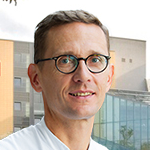An interview with Professor Joachim Ehrlich Head of Cardiology and Electrophysiology St Josef’s Hospital in Wiesbaden, Germany
"The key pillar of any cardiology department is to be able to share information and plan structured therapy together… Now you don’t have to switch from one system to another as you have all the information in one program".

Dr. Joachim Ehrlich has had a major goal throughout his career; the integration of all cardiology department datapoints into one system. In partnership with Ebit this has become a reality and together they continue to push the boundaries of what can be done to deliver the best workflow management, increasing efficiency for physicians and improving the quality of patient care.
With a long stream of research papers published in the journal, Heart Rhythm, Dr. Joachim Ehrlich has extensive experience across all levels of cardiology, scientific expertise in cardiac electrophysiology and has also focused on atrial fibrillation research. For the last three years, as Head of Cardiology & Electrophysiology at St Josef’s Hospital, he has been working closely with other cardiologists and attending physicians, towards uniting and improving procedures for patients on the ward through the rollout and continuous development of a Cardiovascular Information System (CVIS).
St. Josef’s Hospital in Wiesbaden has a cardiovascular surgery in collaboration with the University of Mainz. The cardiology department boasts a wealth of experience allowing them to provide all current cardiology procedures and techniques available, ranging from coronary angiograms, electrophysiology, PM/ICD, imaging, MRI, CT, Intravascular, Structural Heart and Endovascular.
Interview with Dr. Joachim Ehrlich
The importance of focusing minds
With such a comprehensive scope within cardiology, located in such an important part of Germany, it is essential that the department is soundly structured as Dr. Ehrlich explains: “We need many different specialties working here and we have so much great experience for instance in angiology and radiology, but also across all aspects of cardiology. In general patients often have a large, diverse set of diagnoses, hence needing experts in many fields”.
This complexity increases the importance of having structured access to all patient charts, and as Ehrlich continues: “The key pillar of any cardiology department is of course being able to qualify all the focus of different minds, to be able to share information and plan structured therapy together. I’ve been Head of Cardiology departments for more than ten years and we have often had bits and pieces of IT structure that do not fit well together. My major career goal has been to integrate all imaging and therapy procedures into one system”.
Delivering better therapy through a flexibly structured CVIS
Working with Ebit has brought the department well along the path to this goal of providing a complete cardiological patient history, but this wasn’t enough for Ehrlich: “For me personally the key issue is that the CVIS must have the flexibility to adopt all views of the therapy, but maintain them in a specific pre-formed structure. Now all our physicians in the cath-lab use identical text blocks, for various different therapies”. But having this structure also saves time: “Now you don’t have to switch from one system to another as you have all the information in one program – structured reporting of text, raw data, measurements and images”.
All historical patient documents are available and at the centre of the heart team discussions on optimal treatment for a patient with structural heart disease and as Dr. Ehrlich proudly states: “It is all so easy to access. We can have all this data at any point in the hospital, on the ward or in clinic. We’ve never had this before”.
Integration improvements continue to easily deliver increased added-value
Establishing a patient-centric and evidence-based care process that allows all physicians to access and share information, as well as plan daily activities together has become a cornerstone of the heart team’s work. The transition for the team was quick and now there is a regular rhythm: “It was very easy to share the system with the team, as it has been with the constant improvements which we are working on including important post-processing tools. We now have the option to integrate external collaborators studies and data into our own CVIS and I believe this will be a future path that all cardiology departments should pursue. The direct transfer of outside data for a heart team handling complex patients with structural heart disease conditions would be a great asset”.
The future for St-Josef’s Hospital and Ebit
The evolution of the PACS and CVIS system continues apace. The German Healthcare system has a strict division between out-patient and in-patient settings and work is now underway to deliver inter-sectoral transmission of data as patients transfer between the two.
As well as being important in terms of legal issues, having clear structured and continuous patient documentation offers many opportunities to improve patient care. So whether a patient is referred to the hospital for treatment, or arrives in the emergency department, physicians can easily combine previous patient documentation whilst recording all of his current vital signs throughout the procedures.
Dr. Joachim Ehrlich concludes: “We would be very happy to incorporate all patients previous data into our system and with Ebit it is a continuation of the collaborative process to improve the system together. As well as delivering to our suggestions, they also bring us additional novel developments which we’ve always been able to integrate allowing us to keep improving our standards and looking forwards to the future”.
Contact us for more information
Read other Clinical Stories
A technological dream come true
An interview with Professor Shmuel Banai, Director; Division of Cardiology, The Tel Aviv Souraski Medical Center, Tel Aviv, Israel
A new Heart Team patient centric philosophy
An interview with Prof. Carlo Trani, director of the Interventional Cardiology and Invasive Diagnostics Unit at Gemelli...



